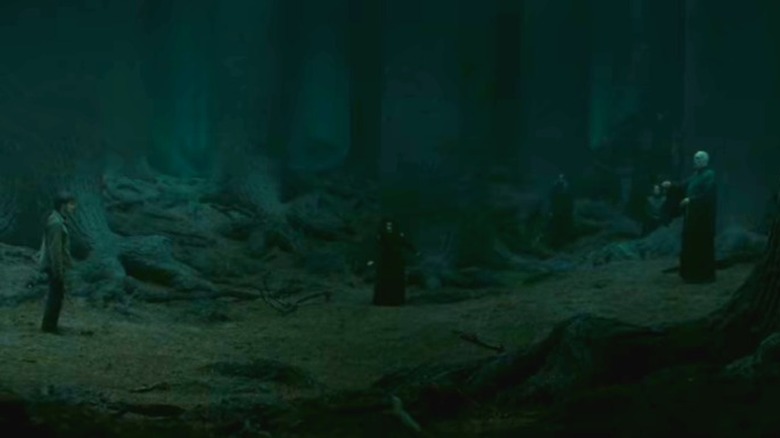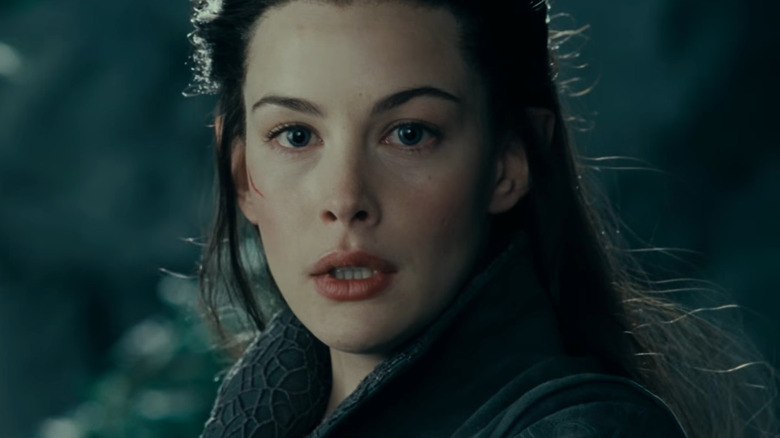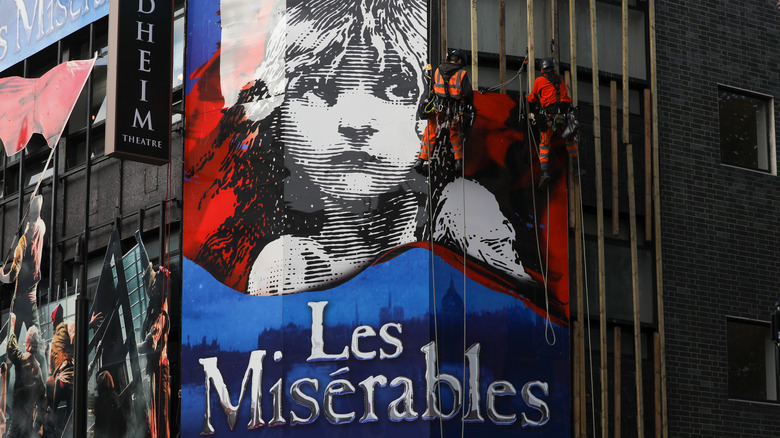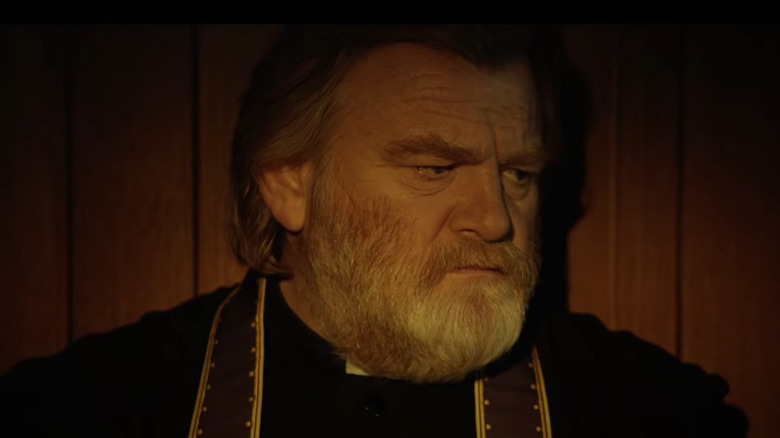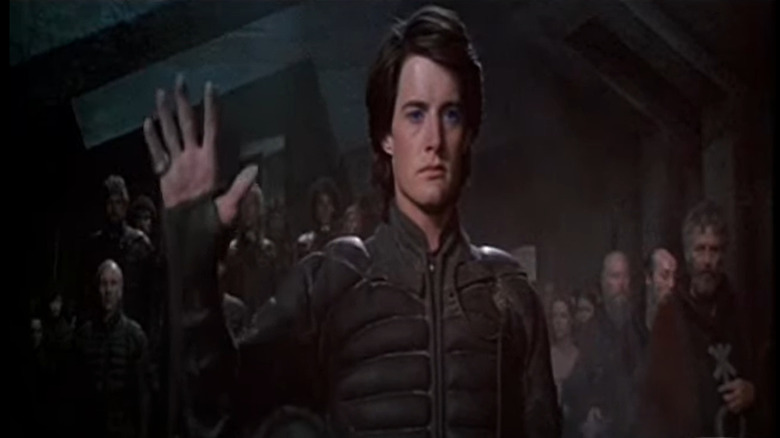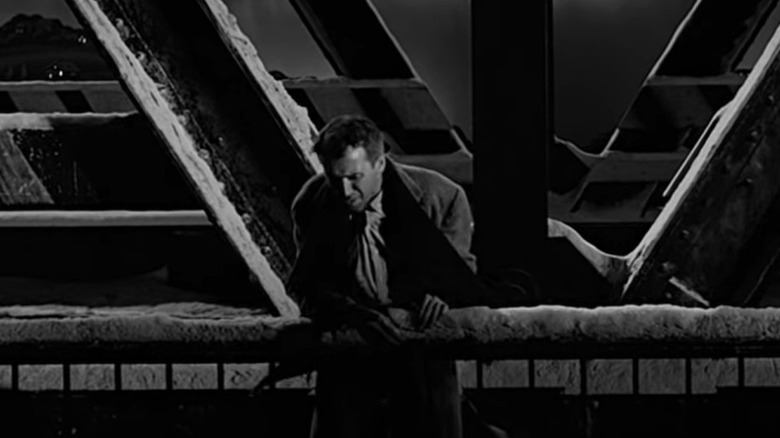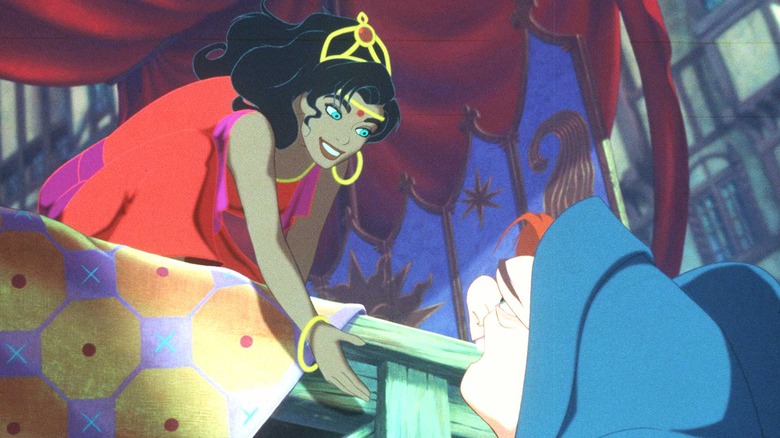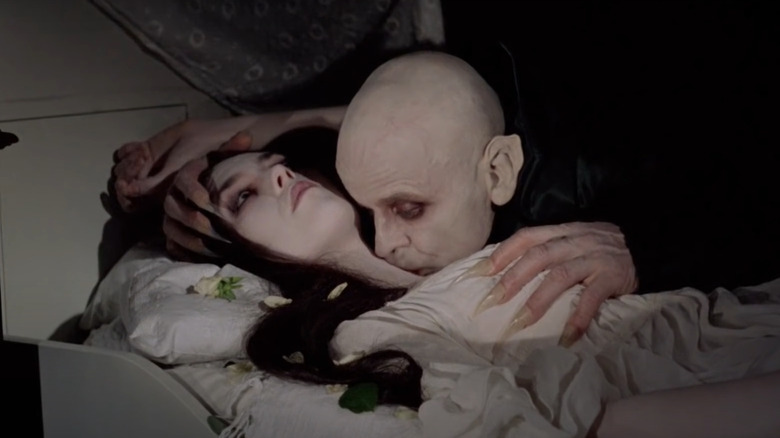Movies That Use Storylines Straight From The Bible
According to Professor Mark Noll of Houston Baptist University, no book has had as much impact on American culture and society as the Bible. This collection of Christian scriptures helped the United States establish its identity from the earliest colonial times and continues to impact American culture. Whether through the use of idioms inherited from the King James Bible (via NPR), the creation of large numbers of Bible-based movies and TV shows, or the celebration of numerous holidays, it is difficult to spend a day without referencing the Bible at least once. Most English speakers probably do so without even realizing it.
But the Bible has also affected secular art and media. Many classic movies that people enjoyed as children and adults are filled with Biblical imagery and tropes, both intentionally and otherwise. Sometimes, the directors have subverted the Biblical images, but the book's influence remains. Here are some movies that seem to have taken their storylines straight from the stories of the Bible and reimagined them in new settings.
Harry Potter and the Deathly Hallows
The "Harry Potter" series, both in print and on screen, has been frequently criticized in conservative Christian circles for depictions of witchcraft and magic. Catholic and Evangelical organizations, according to Forbes, have even banned the series. But according to Premier Christianity, author J.K. Rowling relied on the Gospels to help craft her wizarding narrative. The final installment of the series draws themes directly from the Passion and Resurrection of Jesus Christ.
The concept of resurrection appears in the first "Deathly Hallows" movie. According to the University of Pittsburgh, while Harry and Hermione stand in front of Harry's parents' grave in Godric's Hollow, one can make out 1 Corinthians 15:26, which reads that "the last enemy that shall be destroyed is death." Christians believe that by dying on the cross, Jesus destroyed death, and this idea appears in Harry Potter, wherein the main character becomes a Christ figure that destroys the embodiment of evil, the dark wizard Voldemort.
In the "Deathly Hallows," Harry realizes that he is the final Horcrux, a vessel containing part of Voldemort's soul that must be destroyed for the dark wizard to die permanently. To destroy this part of Voldemort and save the wizarding world, Harry must sacrifice himself. Despite Voldemort's mockery, Neville Longbottom notes that Harry's death was not in vain. It was for everyone. Harry then springs forth from the dead in a Christ-like resurrection. In the ensuing battle, Voldemort is defeated, since Harry's death destroyed the piece of his soul that allowed him to stay alive. In this regard, Harry Potter is a reimagination of Christ's life, as noted by Presbyterian minister John Killinger (via UPitt).
The Lord of the Rings
"Lord of the Rings" fans might miss the series' Christian themes. Overt, organized religion is virtually absent from a Middle Earth filled with monsters, wizards, and elves. But as Christianity Magazine notes, author J.R.R. Tolkien was Catholic, and it shows in Peter Jackson's film rendition. There are too many biblical inspirations in "The Lord of the Rings" to discuss fully. The Chalcedon Foundation analyzes some of the major character's biblical analogues, such as Frodo, Gandalf, and Aragorn. But one of the less obvious analogues is the half-elven princess of Rivendell, Arwen Undomiel.
Arwen rarely comes up as a Marian figure. The Conciliar Post focuses mostly on Galadriel and Eowyn. Arwen is only mentioned towards the end as a footnote. But Peter Jackson's trilogy expands her role and turns her into a Marian figure. After rescuing the story's protagonist Frodo from black-clad riders, Arwen prays for Frodo to be spared from his wounds through "what grace is given [her]." Page 17 of the movie score explicitly says that Arwen's prayer is addressed to the Valar, divine beings that serve the supreme god of Middle Earth, Eru-Iluvatar. As Memorial University notes, she behaves as an intercessor, mirroring Catholic beliefs about the Virgin Mary. This scene, which is absent in the books, is interpreted as Arwen saving Frodo's soul and signaling her intention to give him the gift of eternal life in the Undying Lands of Valinor.
Les Miserables (2012)
The musical version of Victor Hugo's classic 1862 novel follows the original in placing Christian themes front and center. In the 2012 movie, Jean Valjean is a poor man struggling to feed his family. After stealing a loaf of bread, he is sentenced to prison and continues with a life of crime after his release, stealing silver candlesticks from a bishop who had the kindness to take him in. According to the Universal Life Church, at this point, the parable of the Good Samaritan makes its appearance.
The bishop is portrayed as the Good Samaritan. He fed and clothed the destitute Valjean and even saved him from prison after Valjean stole from his host. All the bishop expects in return is that Valjean follows Jesus' instructions to "do likewise." The ex-convict Valjean then becomes an honest and charitable businessman, even adopting the destitute Cosette from her sex worker mother.
According to Think Christian, the New Testament Parable of the Unmerciful Servant also plays a role in the movie. Inspector Javert is the foil to Jean Valjean. Born in prison, this zealous executor of the law refuses Jean Valjean any mercy for his crimes. Think Christian notes that Javert's refusal is a reminder that Christians must forgive their transgressors. In the movie, Valjean forgives Javert for his treatment and even saves him from execution. But a confused Javert cannot understand the work of God's grace in Valjean. To him, Valjean will always be a criminal and should be treated as such. Javert cannot return mercy to his former prisoner, just as the unmerciful servant refused mercy to others, despite it having been shown to him.
The Lion, the Witch and the Wardrobe
"The Lion, the Witch and the Wardrobe" is an obvious case of a Bible-based storyline. According to the Gospel Coalition, C.S. Lewis intended to write a Christian story, even though, strictly speaking, it is not an allegory. The Christian undertones were undeniable. The lion Aslan is very much a Christlike figure whose story mirrors that of Jesus during the Passion almost exactly.
Aslan sacrifices his life to save the young Edmund, who had fallen into the clutches of the White Witch Jadis and aided her in evil, albeit unintentionally. The scene bears obvious parallels to Christ's death, as Aslan is bound and tortured by Jadis' host of evil creatures and animals before being killed. But he rises from the dead, making "death itself turn backwards," and helps Peter lead the armies of Narnia to crush Jadis' forces.
The Christian pedigree of "Narnia" is obvious. Yet, according to Reuters, the series has caused controversy due to its Christian background. C.S. Lewis himself confirmed Aslan's role as a Christlike figure. Aslan was created as a lion in ode to Christ's title as the "Lion of Judah." But actor Liam Neeson rejected Aslan's Christian background, painting him instead as a universal religious figure, for which Christians roundly criticized him. In the end, this may have been purely marketing. The filmmakers wanted the series to appeal to a broad audience, despite the fact that, at its core, the "Narnia" series is unique and solely Christian.
The Lion King
Unlike many other movies on this list, "The Lion King" draws its parallels from the Old Testament — namely, the Book of Exodus. According to Oprah Daily, the producers of "The Lion King" explicitly said that the movie draws inspiration from the story of Moses, who comes out of the desert to save his people from oppression and slavery. Jewish magazine Kveller notes that both Simba and Moses lived outside of their respective societies, in a way becoming people they were not. Simba lives as a layabout in the middle of the jungle with no worries, abandoning his responsibilities. Moses ceases to be a Hebrew, instead becoming a prince of Egypt and part of the family that had killed many of his countrymen.
The story of "The Lion King" does not end with Simba's exile. Simba eventually returns to claim his kingdom somewhat reluctantly after several characters remind him of who he is. Much in the same way, God reminds Moses of his destiny to lead the Hebrews out of Egyptian slavery and into the Promised Land. Simba reclaims his identity as a lion and a king, while Moses reclaims his identity as a Hebrew and a Jew, both realizing their purposes on earth and continuing the circle of life.
Calvary
This movie is a unique take on the clerical sex abuse scandal in Ireland from the perspective of a priest. The protagonist Father James serves a small Irish town full of unsavory types, from cheaters to domestic abusers to serial killers. Father James is by all accounts a good man and priest, but according to a penitent, he will die in seven days. The killing will be the penitent's revenge for sexual abuse endured at the hands of other priests as a child.
According to the Boston Globe, Father James' journey was originally based on Jesus' Passion. However, when the movie became too long, they changed it to the five stages of grief, a more secular take. But the overarching message is still incredibly Christian. Father James, according to U.S. Catholic, must die for the sins of the Catholic Church. This brings up obvious parallels to Christ, who died to forgive the sins of humanity. According to the Charlotte Observer, Father James is marching towards his own Calvary, the place where Jesus was crucified.
But the biblical basis of the movie is not limited to Father James' "sacrifice." The priest, who does his best to minister to a proudly sinful congregation, is repeatedly mocked for his efforts, recalling Jesus' treatment at the hands of his killers in the Gospel of Matthew. The good, devout priests who care about their congregations must bear the brunt of the public backlash to the clerical sex abuse scandal, despite being innocent of the sins of their fellow priests.
Dune (1984)
David Lynch's "Dune" does not immediately appear to have any biblical references outside of shared vocabulary. The introductory monologue of Princess Irulan, the narrator of the movie, mentions that the Fremen, the inhabitants of the desert planet Arrakis, await a "messiah" to bring "true freedom." This compares to the biblical narrative favorably, at least so far. As the Rome Sentinel notes, Jesus brought freedom from sin and an oppressive world through eternal life. "Dune," however, inverts the Christ-figure trope into something thoroughly antithetical to the Christ narrative.
Paul Atreides is the movie's Christ figure. But Mockingbird Magazine notes that he bears little resemblance to the messiah mentioned in the Gospel of Luke that would "proclaim good news to the poor." Escapist Magazine notes that Paul more closely resembles the "messiah" of Leni Riefenstahl's 1938 German propaganda film Triumph of the Will, and in this scene, it is easy to see why. Instead of sacrificing himself as Jesus did, Paul unleashes an army of cult-like followers, who kill their way across the planet of Arrakis. This devotion evokes images of an almost-religious devotion to Riefenstahl's messiah, Adolf Hitler, who presented himself as Germany's savior after its defeat in World War I. Paul wields his messiahship as a political-religious weapon to crush his enemies in vengeance against his father's killers. He is the harbinger of divine justice. The world of "Dune" believes in God, and Paul is his hand. "One cannot go against the word of God," and on Dune, Paul's word and God's word appear synonymous. Instead of bringing the Gospel to all the nations, Paul would bring peace where there was war and love where there was hatred, regardless of how much blood had to be spilled to accomplish it.
It's a Wonderful Life
Frank Capra's 1946 classic "It's a Wonderful Life" is a Christmas favorite. It follows the story of common man George Bailey, who seeks to end his life after a series of financial reverses. Daniel Sullivan of the Catholic University of America draws a strong biblical parallel to the Book of Job, which he sees as the basis for the movie's plot. Sullivan makes a strong case. Both the biblical Job and Capra's protagonist are devout, strong, family-oriented men who positively impact the lives of those around them. Yet they both suffer.
In the Bible, God allows Job to suffer at Satan's hands, even though Job should not deserve such treatment due to his righteousness. Eventually, Job despairs of his existence, wondering if it would be better had he never been born. Bailey goes through the exact same crisis after a financial disaster nearly shuts down his business. Despite his role as a pillar of the community, he quickly gives into despair and tries to kill himself by jumping off a bridge. But the suffering has a purpose in the end. Job is blessed for having endured such suffering in the Bible with plentiful children, including three beautiful daughters. After Bailey's guardian angel shows him the positive impact his life has had on others, Bailey backs off suicide to find that his fellow townspeople have rewarded his goodness by saving his business from ruin.
The Hunchback of Notre Dame
This classic of Disney animation is the most overtly religious Disney movie. The Catholic faith plays a central role, which, according to the Catholic Register, reminds viewers of the biblical parable of the Pharisee and the Tax Collector (also known as the Publican). Antagonist Judge Claude Frollo is compared to the Pharisee. Frollo's prayer "Hellfire," begs the Virgin Mary to help him catch the Roma, Esmeralda. His justification? He is more virtuous and devout than the lowly commoners and thanks God that he is not like them. Yet he has no problem killing innocents and engaging in general unsavory behavior, making his piety nothing more than a mask. This parallels the Pharisee in the Bible, who thanks God for not making him like the commoners and sinners.
Frollo's foil is the beautiful Esmeralda, whom the Ursuline Sisters compare to the tax collector of the biblical parable. Esmeralda is poor and makes a living as a dancer. Being Roma, she is an outcast in French society. In her prayer "God Help the Outcasts," Esmeralda's fellow parishioners at Notre Dame Cathedral, like Frollo, pray for their personal desires. But Esmeralda acknowledges her lowly status before the Virgin Mary and baby Jesus, even though she considers herself unworthy to ask anything of God. Yet, she has the faith to pray for God's mercy for society's outcasts, such as herself. In this regard, she is comparable to the tax collector, who asks for God's mercy for his sins. Ultimately, Jesus' words ring true. Due to his pride, Frollo is humbled, while lowly Esmeralda and the hunchback Quasimodo become exalted heroes through their righteousness, humility, and courage.
Nosferatu
Vampire movies often carry Christian themes, and Werner Herzog's 1979 film "Nosferatu: Phantom der Nacht," is no exception. This movie, loosely based on Bram Stoker's novel "Dracula," pits the vampire — whom film scholar Ira Konigsberg calls an anti-Christ — against the pure and unblemished Lucy Harker. Yet, this film appears to overturn the Christian message in more ways than one.
Dracula brings plague and death to the small town of Wismar, Germany. No one seems to know how to stop the plague, which defies all scientific attempts to end it. The biblical parallels are present here. According to Lloyd Michaels, the movie presents a creepy parody of the Last Supper, in which locals share a last meal before dying of plague. But there is no hope in the scene. Death's triumph is inevitable, contrary to Christian belief.
According to Senses of Cinema, only Lucy, the "pure of heart" wife of real estate agent Jonathan Harker, traces the plague to Dracula. Realizing the vampire must die, she decides to sacrifice herself to that end. When Dracula comes into her bedroom, she allows him to touch her sexually and guides him to her neck. Dracula is so taken with her that he loses track of time. The sunrise kills him, saving Wismar from Dracula's plague. Lucy, however also delivers Dracula from the undead and allows him to find peace in death. Her sacrifice is an act of Christian love for her husband and Dracula, and it evokes Jesus as the "spotless and innocent lamb" sacrificed on the cross for mankind's sins. But unlike Christ, her act may be in vain, since she is unable to save her husband from becoming a vampire.
Star Wars: Return of the Jedi
The "Star Wars" franchise has been mined for biblical references, and none is more controversial than the (anti)Christ role of Darth Vader. However, Harvard professor Cass Sunstein has made a strong argument for why Darth Vader, despite being evil, is in some ways a Christ figure, albeit an inverted one. According to Catholic Exchange, Darth Vader is the series' antichrist to the devil himself, Emperor Palpatine.
Sunstein (via Business World Magazine) argues that Darth Vader is "an imaginative reconstruction of Jesus's life." The Washington Post views it as a subversion of Christianity, a what-if story if Jesus had caved to the devil's temptation. Both make valid arguments. Vader, like Christ, was born to a virgin without an earthly father. As Obi-Wan Kenobi noted in "Revenge of the Sith," Vader (as Anakin Skywalker) was the Chosen One that would bring balance to the Force. But unlike Christ, Anakin gives in to satanic figure Palpatine's temptations and offers of power and immortality.
Although Vader embraces an antichrist role, even he can find redemption and become the Christ figure. In "Return of the Jedi," Vader eventually turns on Palpatine and kills him to save his son Luke from death. But Palpatine's Force lightning kills him, too, turning Vader's act into a heroic sacrifice for his son that puts an end to Palpatine's reign of terror. Thus, Palpatine's agent of evil who murdered innocent children redeems himself of his previous heinous acts and saves the galaxy.

